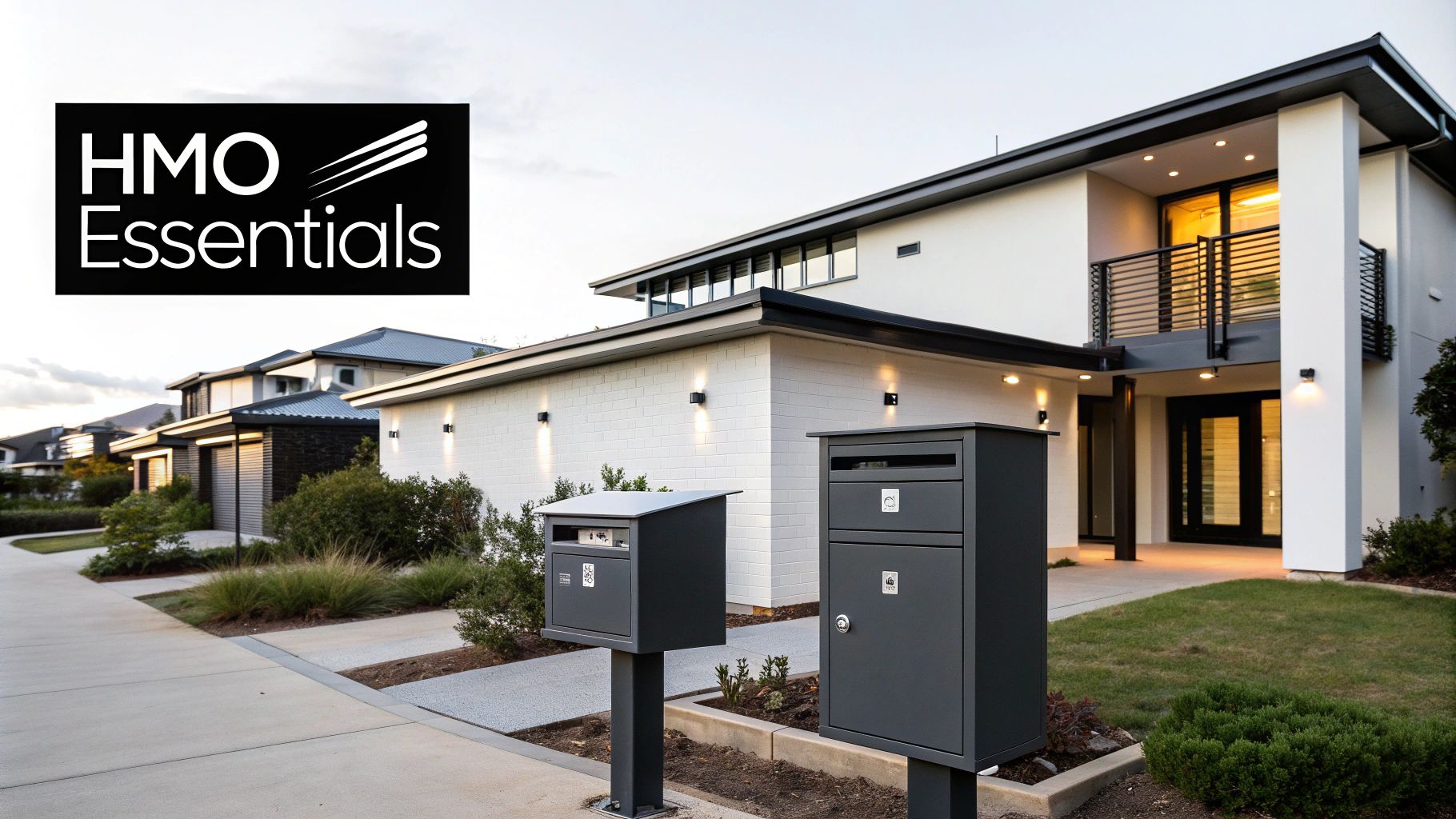Understanding HMO Properties

Houses in Multiple Occupation (HMOs) offer a distinct investment opportunity within the property market. Essentially, these properties house three or more tenants from separate households, sharing common facilities like kitchens and bathrooms. This shared living arrangement sets HMOs apart from other rental properties and requires a different approach to financing. This means you won't be able to secure a standard residential mortgage for an HMO property. Instead, you'll need a specialized HMO mortgage designed specifically for the risks and rewards of this investment type.
A key difference between HMOs and single-let properties lies in the potential rental yield. For instance, consider two similar properties in the same neighborhood: one rented to a single family and the other operating as an HMO. The HMO, with its multiple tenants, will likely generate a considerably higher monthly rental income. This increased earning potential is a major attraction for investors. However, this higher potential income comes with added management complexities. Managing multiple tenants and ensuring adherence to HMO regulations requires more effort than a single tenancy. This increased responsibility is reflected in the specific requirements lenders impose for HMO mortgages.
Furthermore, lenders evaluate HMO properties differently than standard buy-to-let properties. They carefully consider factors like the property's license (if required locally), the number of tenants, and the overall condition and suitability for shared living. They also scrutinize the investor's experience managing HMOs. This more thorough assessment stems from the unique risk profile HMOs present. As an example, the higher tenant turnover often seen in HMOs can lead to vacancy periods, potentially impacting mortgage repayment. Consequently, lenders place significant emphasis on the investor's ability to effectively manage the property and maintain consistent rental income.
Moreover, HMO mortgages often have distinct terms and conditions compared to standard buy-to-let mortgages. Interest rates may be slightly higher, and a larger deposit might be required, reflecting the perceived higher risk. Understanding these differences is vital for investors entering the HMO market. This knowledge empowers investors to make informed decisions and secure the most appropriate financing. The right HMO mortgage forms the foundation of a successful HMO investment strategy, enabling long-term profitability and growth within this specialized sector.
HMO Mortgage Requirements

Obtaining an HMO mortgage requires meeting specific criteria that differ from standard residential or even typical buy-to-let mortgages. These requirements reflect the unique nature of HMOs and the associated risks. Grasping these stipulations is crucial for anyone considering the HMO market. Prospective HMO landlords should be prepared for more stringent criteria than those for a standard mortgage.
Personal Finances and Credit History
A core requirement for an HMO mortgage centers on the applicant's financial standing. Lenders thoroughly examine credit reports, looking for any indicators of financial trouble. A solid credit score is essential, demonstrating responsible financial management and the ability to handle debt. While this is true for other mortgages, the standards are generally higher for HMOs. Lenders also typically require proof of income, often at a higher level than for standard buy-to-let mortgages. This provides a safety margin against potential rental income fluctuations, ensuring the borrower can comfortably afford repayments, even during vacancies.
Experience and Expertise
In addition to financial health, lenders also evaluate the applicant's property management experience, especially with HMOs. Although not always mandatory, previous experience managing multiple tenants can greatly strengthen an application. For example, a successful track record managing an HMO demonstrates the applicant's capacity to handle the complexities involved. This can often translate into better mortgage terms. Some lenders might also ask for a detailed business plan outlining the HMO investment strategy, including projected rental income, expenses, and a clear understanding of the local HMO market.
Property Specifications and Licensing
The property itself undergoes a rigorous assessment for HMO mortgage applications. Lenders inspect the property's condition, verifying that it meets specific safety and habitability standards, such as adequate fire safety measures, proper ventilation, and sufficient kitchen and bathroom facilities. Moreover, the property must comply with local council regulations regarding HMO licensing. Many areas require a license, confirming the property meets shared housing standards. Obtaining this license is often a prerequisite for an HMO mortgage. This ensures legal compliance and reduces lender risk.
Deposit and Loan-to-Value Ratio
Lastly, the deposit required for an HMO mortgage is usually higher than for a standard buy-to-let property. Lenders often ask for at least a 25% deposit, though this can vary. The larger deposit mitigates lender risk, addressing the perceived higher risk of HMOs. This also affects the loan-to-value ratio (LTV), the percentage of the property's value the lender will finance. A lower LTV, due to a higher deposit, can often result in more favorable mortgage rates and terms. Understanding these deposit and LTV requirements helps prospective HMO investors accurately assess the initial investment needed and the potential returns.
Application Process
Securing an HMO mortgage might appear daunting, but breaking it down into manageable steps simplifies the process. Understanding this journey is key to navigating HMO finance and becoming a successful HMO landlord. Careful planning and preparation can considerably improve your chances of obtaining the right mortgage.
Initial Consultation and Research
The first step involves thorough research and consultation. Start by researching different lenders and comparing their HMO mortgage offerings. Just as you would compare prices when buying a car, comparing interest rates, fees, and loan terms is crucial. Consulting a specialist HMO mortgage broker is also recommended. Their expertise in the HMO market can provide valuable guidance during the application process, helping you find suitable lenders and negotiate optimal terms.
Pre-approval and Documentation
After identifying a potential lender, the next step is pre-approval. This involves submitting financial information like income statements, tax returns, and credit reports. This is essentially presenting your financial credentials to the lender. A strong financial profile showcasing stable income and responsible debt management significantly strengthens your application. Gather all necessary property-related documents, including the HMO license (if applicable), property valuation reports, and any relevant planning permissions. Having these readily available streamlines the process and demonstrates your preparedness.
Formal Application and Underwriting
With pre-approval and documentation prepared, you can proceed with the formal mortgage application. This involves completing a detailed application form with comprehensive information about yourself, your finances, and the property. This is like submitting a comprehensive report; accuracy and completeness are essential. The lender will then undertake a thorough underwriting process, assessing your application and verifying the information provided. They may also require additional documentation or clarifications. This ensures the lender fully understands your financial situation and the HMO investment's viability.
Offer and Completion
If your application is successful, the lender will issue a formal mortgage offer. Carefully review the terms and conditions before accepting. This is a legally binding agreement, so understanding all the details is crucial. Once you accept the offer, the final step is completion, which involves the transfer of funds and legal acquisition of the HMO property. This marks the end of the application process, allowing you to officially begin your journey as an HMO landlord. Securing the right HMO mortgage is a significant milestone, setting the stage for a profitable and rewarding investment.
Lender Comparison

Once you understand the application process and requirements for an HMO mortgage, the next critical step is comparing different lenders. Just as you wouldn't buy the first car you see, don't settle for the first HMO mortgage offer. Each lender has its own criteria, interest rates, fees, and loan terms. Careful comparison is crucial to secure the most advantageous deal for your investment. While this can seem overwhelming, focusing on key factors simplifies the decision.
Interest Rates and Fees
The interest rate is one of the most significant factors. Even a small difference can lead to substantial savings over the loan term. A 0.5% difference on a £200,000 mortgage, for example, can save thousands of pounds over 25 years. Also, consider associated fees like arrangement, valuation, and legal fees. These vary considerably between lenders and add to the overall mortgage cost. Factor in both the interest rate and fees for a complete cost picture.
Loan Terms and Flexibility
Beyond rates and fees, examine the loan terms carefully. Consider the loan duration, repayment options, and any lender flexibility. Some lenders offer more flexible terms, like overpaying or making underpayments, which can help manage your cash flow. This flexibility is valuable if your rental income fluctuates. Overpaying during high occupancy periods can significantly reduce the overall mortgage cost, while the option to make underpayments during leaner times provides a safety net.
Lender Specialization and Experience
The lender’s experience and specialization in HMO mortgages are also important factors. Some lenders specialize in HMO lending, possessing a deeper understanding of this market. Their expertise can be invaluable in navigating the complexities of HMO mortgages. They may offer tailored products and services for HMO investors, which can streamline the application process, especially for first-time HMO investors.
Customer Service and Support
Finally, consider the lender’s customer service and support. A responsive and helpful lender can reduce stress throughout the process. Look for lenders with a good reputation for customer service and clear communication, which is especially valuable during the potentially complex and time-consuming application process. Proactive communication and timely updates from the lender can significantly reduce stress, letting you focus on other aspects of your HMO investment, like property management and tenant acquisition. By carefully comparing these factors, you can secure the best HMO mortgage for your investment needs. A resource like theHMOmortgagebroker can be extremely helpful in navigating these complexities. Their HMO finance expertise allows them to provide comprehensive comparisons and tailored solutions aligned with your unique investment goals.
Legal Considerations
Understanding the legal aspects of HMOs is essential for any investor pursuing an HMO mortgage. This involves understanding specific regulations and ensuring compliance to avoid potential legal issues. This due diligence is as crucial as securing the right financing and significantly impacts your investment's long-term success. Overlooking legal aspects can have costly consequences, jeopardizing your investment and potentially leading to hefty fines.
Licensing Requirements
A primary legal consideration for an HMO mortgage is licensing. Many local authorities require HMOs to be licensed, particularly those housing five or more tenants forming two or more households. This license certifies the property meets specific safety and habitability standards, such as adequate fire safety measures, sufficient kitchen and bathroom facilities, and proper ventilation. Securing this license is often a prerequisite for an HMO mortgage because lenders need assurance of legal compliance. This reduces lender risk and demonstrates your commitment to operating a legally sound HMO.
Planning Permission and Building Regulations
Planning permission and building regulations are also crucial. Any significant structural changes to the property, such as converting a single-family dwelling into an HMO, might require planning permission. This ensures compliance with local development plans and prevents negative impacts on the surrounding area. Building regulations govern construction and renovation, ensuring properties meet safety and structural standards. For instance, complying with building regulations is mandatory when adding an extension or modifying the internal layout of your HMO. This protects tenants and the investor, ensuring the property is safe and structurally sound.
Tenant Rights and Responsibilities
Understanding tenant rights and responsibilities is paramount for any HMO landlord. HMO landlords have specific legal obligations, including providing a safe and habitable living environment. This means ensuring the property is well-maintained, providing adequate heating and hot water, and addressing repairs promptly. For example, landlords are legally obligated to fix a faulty appliance or a leaking roof within a reasonable timeframe. Failing to meet these obligations can lead to legal disputes and potential financial penalties. Landlords must also adhere to specific regulations regarding tenancy agreements, deposit protection schemes, and eviction procedures. This protects both landlords and tenants, ensuring a fair and legal tenancy agreement. Understanding and addressing these legal considerations is essential for securing an HMO mortgage and ensuring a successful and legally compliant investment. It showcases responsible property management and fosters positive tenant-landlord relationships, contributing to your HMO venture's long-term viability.
Financial Planning

Successful financial management of an HMO investment requires careful planning and budgeting. A robust financial plan is crucial for securing and managing an HMO mortgage, just as a ship needs a detailed chart to navigate challenging waters. This careful planning helps investors mitigate potential risks and maximize returns in the complex world of HMO property management. Understanding the financial implications is as important as understanding the legal and regulatory aspects.
Budgeting and Forecasting
Creating a comprehensive budget is the first step in sound financial planning for an HMO. This involves accurately forecasting potential income and expenses. This budget acts as your financial guide, informing your investment decisions and ensuring you stay on track to achieve your financial goals. Accurately projecting rental income is essential for determining your ability to meet mortgage repayments. Overestimating rental income can lead to financial difficulties, while underestimating it might cause you to miss out on profitable opportunities.
Predicting expenses accurately is equally critical. Consider not only mortgage repayments but also other operating costs like property maintenance, utility bills, and council tax. Unexpected repairs, for example, can significantly impact your cash flow if not budgeted for. Regular maintenance and proactive property management can minimize these unexpected costs and contribute to your HMO investment's long-term financial health.
Cash Flow Management
Effective cash flow management is vital for any HMO investment. This means closely monitoring income and expenses to ensure sufficient funds to cover all costs. Think of your HMO as a small business. Just as a business must manage its cash flow to remain viable, so must an HMO investment. Healthy cash flow ensures you can meet your financial obligations – mortgage repayments, property taxes, and insurance premiums – without financial strain. It also provides a buffer against unexpected expenses, like urgent repairs or periods of vacancy.
Establishing a reserve fund is a good strategy for cash flow management. This fund acts as a financial safety net, cushioning against unforeseen expenses or periods of reduced rental income. If a major appliance breaks down or you have a vacancy between tenants, for instance, a reserve fund can prevent you from falling behind on mortgage repayments. This proactive approach helps mitigate risks and promotes long-term investment stability.
Refinancing and Equity Release
As your HMO investment grows, explore refinancing or equity release. Refinancing involves switching to a different mortgage deal, perhaps with a lower interest rate or more favorable terms. This can significantly lower your monthly repayments and boost your overall profitability. If interest rates have dropped since you secured your initial HMO mortgage, refinancing could save you thousands over the loan's life. However, be aware of associated fees like early repayment charges or arrangement fees to ensure refinancing is truly beneficial.
Equity release allows you to access the equity you've built in your HMO property. This can provide a lump sum for various purposes, like reinvesting in other properties, funding renovations, or supplementing income. However, equity release is complex and requires careful consideration. Understand the terms and conditions, the potential impact on your future inheritance, and the long-term financial implications before proceeding. Professional financial advice is highly recommended before making decisions about refinancing or equity release.
Need expert guidance navigating HMO finance? theHMOmortgagebroker offers specialized expertise in HMO mortgages, remortgages, and other financial solutions tailored for HMO investors. Their market knowledge and access to a wide range of lenders can help you secure the most advantageous financial solutions, ensuring your financial planning is robust and sets you up for success in the HMO market.

Property Finance Specialist
David Sampson is a property finance specialist with expertise in HMO mortgages and investment property solutions.
